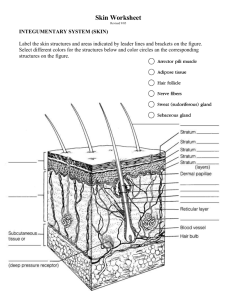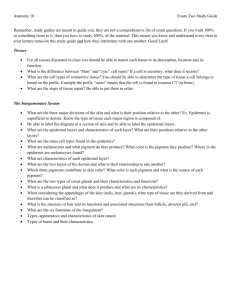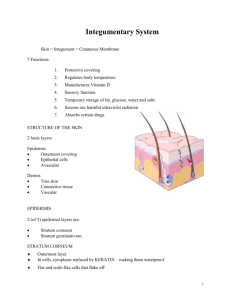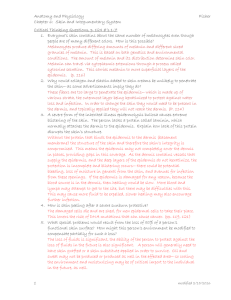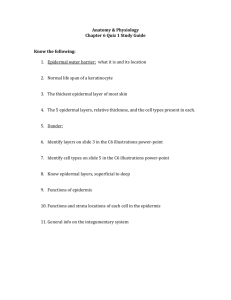Skin structure fcn notes
advertisement
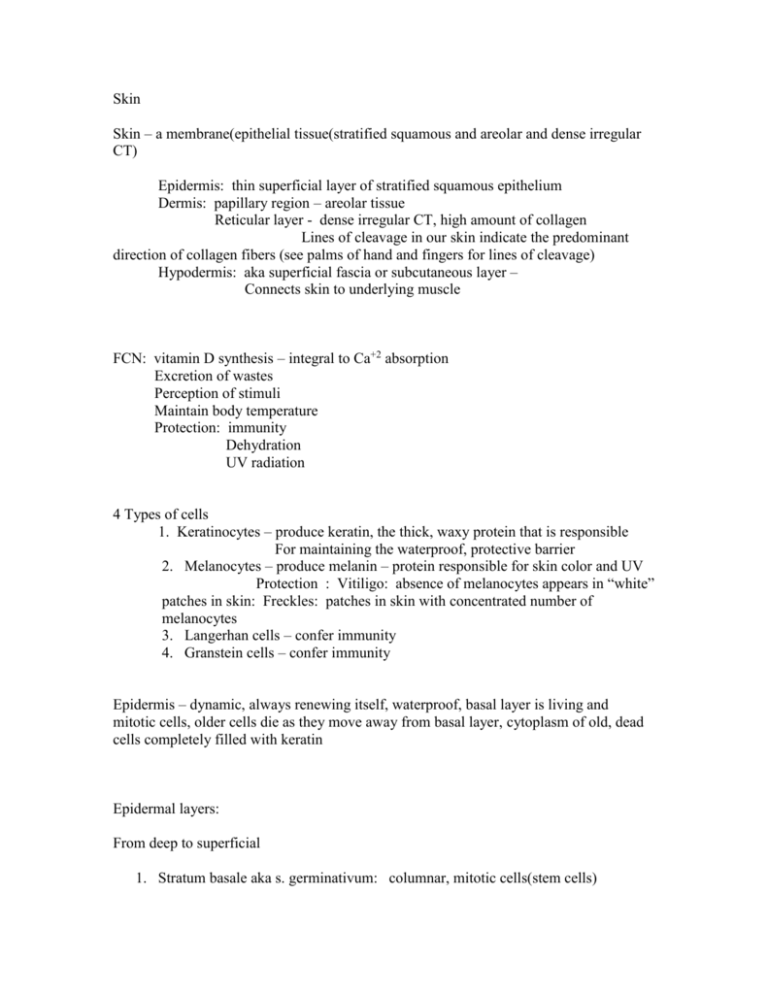
Skin Skin – a membrane(epithelial tissue(stratified squamous and areolar and dense irregular CT) Epidermis: thin superficial layer of stratified squamous epithelium Dermis: papillary region – areolar tissue Reticular layer - dense irregular CT, high amount of collagen Lines of cleavage in our skin indicate the predominant direction of collagen fibers (see palms of hand and fingers for lines of cleavage) Hypodermis: aka superficial fascia or subcutaneous layer – Connects skin to underlying muscle FCN: vitamin D synthesis – integral to Ca+2 absorption Excretion of wastes Perception of stimuli Maintain body temperature Protection: immunity Dehydration UV radiation 4 Types of cells 1. Keratinocytes – produce keratin, the thick, waxy protein that is responsible For maintaining the waterproof, protective barrier 2. Melanocytes – produce melanin – protein responsible for skin color and UV Protection : Vitiligo: absence of melanocytes appears in “white” patches in skin: Freckles: patches in skin with concentrated number of melanocytes 3. Langerhan cells – confer immunity 4. Granstein cells – confer immunity Epidermis – dynamic, always renewing itself, waterproof, basal layer is living and mitotic cells, older cells die as they move away from basal layer, cytoplasm of old, dead cells completely filled with keratin Epidermal layers: From deep to superficial 1. Stratum basale aka s. germinativum: columnar, mitotic cells(stem cells) a. Epidermal ridges = fingerprints, to increase friction, increase grip, epidermis interlocks with the dermal papillae 2. S. spinosum: multiple layer cuboidal cells a. Molecular bridges(desmosomes) begin to break apart, make cells appear prickly b. Nuclei darkened, dying = pyknosis 3. S. granulosum: grainy layer, cytoplasm appears grainy due to increase amount of keratin 4. S. lucidum: only present in palm of hand and soles of feet a. “ghost cells” b. More keratin in cytoplasm 5. S. corneum: 20-50 layers of dead, keratinized, flat cells(squamous) a. Constantly sloughing off(appears like little horns on surface of skin(microscopic) b. Dead cells still bound tog by desmosomes – skin shed in sheets c. Wrinkly skin: water softens keratin, increases skins permeability to water, osmosis in skin cells, water moves out d. Blister: damage to superficial epidermal layers, interstitial fluid lymph)accumulates in pockets FYI: EGF= epidermal growth factor, produced by salivary glands and glands in duodenum(Small intestine) Used to make epidermal sheets for burn victims DERMIS Ct beneath epidermis Matrix = collagen in LARGE amounts Has the consistency of a firm, wet sponge VERY VASCULAR – to exchange nutrients and waste of dermis cells AND Cells of S. basale(germinativum) PAPILLARY REGION: superficial layer, loose areolar tissue, attaches to dermis via PAPILLAE Papillae: finger like projections that extend up into epidermis, like Velcro These papillae form CONTOURS in skin’s surface = FRICTION RIDGES = FINGER PRINTS – genetically determined pattern in palms, soles, fingers, toes, to assist in “grasping”, and to increase friction RETICULAR REGION: Deep to papillary region, much thicker, dense irregular CT, collagen, reticulin and elastin fibers Roots of hair, sebaceous glands(oil), sweat glands, receptors, blood vessels, and toe, and finger nails all epidermal derivatives set into the dermis(reticular region) Aging : changes in production and quality of protein fibers – wrinkles, saggy skin Retinin A – increases blood flow to stimulate dermal repair, wrinkle formation decreases, and existing wrinkles diminish SKIN COLOR Melanocytes – between cells of s. basale, all humans have same # of melanocytes, amount of melanin produced is determined genetically Melanin – protein pigment Greater amount of melanin production = darker skin UV radiation: increases melanin production to absorb harmful UV rays, protecting other skin cells, results in “tan” Carotene – orange/yellow pigment, skin protein, most apparent in fair skin individuals, accumulates in fatty tissue of dermis
